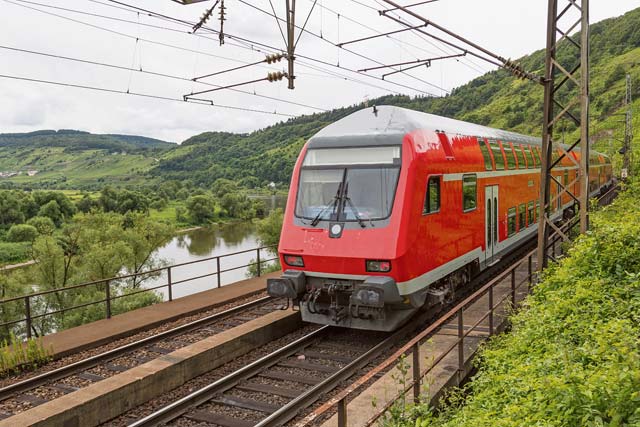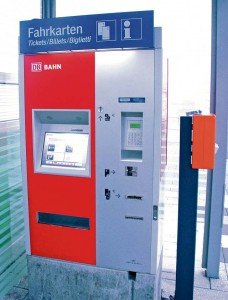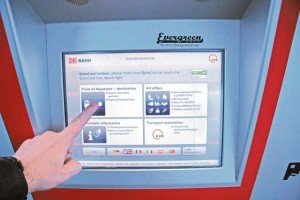Public transport in Germany and throughout Europe is a great way to get around. Whether sightseeing in famous cities, or just getting from home to work, the extensive transit system here services a vast, extensive network of stations and stops that are accessible within walking distance of almost anywhere in Germany.
The public transit system in Germany consists of three levels of transit services. The national transit system, Deutsche Bahn, provides long- and mid-distance service between major cities and hubs. The numerous regional systems, which are also partially serviced by Deutsche Bahn, provide transport between cities and stations in a given region or area. Lastly, the local transit companies provide services within certain cities or districts.
The three levels of the public transit system work together to provide a network that connects to nearly every city, town, or village in Germany. Stops and stations may be serviced by multiple transit agencies or just a single company.

The distinctive red and white trains of the Deutsche Bahn national transit service zip back and forth across Germany delivering passengers between major cities and hubs.
The Deutsche Bahn national transit service
As mentioned earlier, the national transit service is Deutsche Bahn and it provides primarily rail transit between large cities and hubs. Deutsche Bahn also provides some services to stops outside of Germany such as Paris, Vienna and other popular destinations near Germany. Deutsche Bahn trains can be easily recognized by their distinctive red paint with the white DB logo on the side. For offers and ticketing information, go to www.db.de., an English version of the website is offered by clicking next to the German flag and the word ‘Deutsch’ and selecting English from the drop-down menu.
Stuttgart regional transit service
The regional transit service that serves the Stuttgart area is the VerkehrsVerbund Stuttgart, or VVS. This company services routes ranging from Weil der Stadt in the west to Rudersberg Oberndorf in the east and Ludwigsburg in the north to as far south as Filderstadt. Their services include S-Bahn lines, U-Bahn lines, Strassenbahn (streetcar) and a variety of bus lines. Some of the cities and districts within the VVS area also offer their own limited local service lines as well. The VVS has a limited English language webpage at http://www.vvs.de/en/ but those who have picked up a little German, may find more information on their main site www.vvs.de.

Automated ticket tellers (fahrkartenautomat) offer tickets for purchase and can be used to print out travel itineraries. Many have English language interfaces, and some even accept credit cards for purchases.
Tickets, discounts and specials
Each of the various transit companies offers a variety of special deals, discounted tickets and long-term pass deals. Almost all of the national and regional offers can be accessed through the DB website listed above, and information is offered in English. For the full range of offers and deals, check out the DB website listed above.
Ticket prices are generally based on distance, and the type of transport being used. On the DB network, tickets for faster trains such as the Inter-City Express are more expensive than tickets for the same distance on other types of trains. Most regional transit systems use a zone-based pricing system where the region is divided into zones, and a ticket’s price is determined by how many zones the trip crosses.
Zeitkarten, or time tickets, are long term passes offered by various regional transit companies, including Stuttgart’s VVS. These tickets are usually purchased with a given base-station, and cover a given number of zones, so that the ticket can be used for any number of trips anywhere within a certain number of zones from the base station. For example, a ticket purchased with a base in Böblingen for three zones, is good for any travel within three zones of Böblingen, and costs about €90. These tickets are usually good on all forms of regional and local transit within the zone, but some restrictions apply, so ticket holders are advised to check the coverage provided by the ticket they’ve purchased.
These tickets are usually available in monthly or yearly terms, and the yearly tickets, like many other contracts, automatically renew unless explicitly canceled in writing. Most of the regions have an offer for unrestricted travel in the entire network. The VVS offers an unlimited ‘netz’ ticket for about €180 a month.
DB, and VVS both take VAT forms, though some of the customer service agents may not be familiar with them, so it is a good idea to bring the VAT form info sheet available from the VAT office, or be persistent and politely ask the agent to confer with a colleague (for more information on VAT forms see the article on Page 17.
Discounts at the national level include the Deutsche Bahn 25, 50 and 100 cards which are valid on all Deutsche Bahn routes, as well as regional routes when serviced by a Deutsche Bahn train. The 25 and 50 cards provide a basic discount of 25 percent or 50 percent respectively on all DB standard fare ticket purchases. The 100 card offers unlimited travel throughout the entire DB and most of the regional networks as well, but is pricey, coming in at roughly €4,000 yearly, depending on selected options. The prices for these vary based on choice of 1st or 2nd class seating, and discounts are available for certain people (students, elderly etc.). For detailed pricing information visit the DB website.
Navigating the transit systems
At each train station or stop, and also at many local stations and stops, vending machines are available to purchase tickets. These machines can also be used to plan a route across a wide number of stations and changes. Usually, a travel itinerary can be printed out. This itinerary shows bus or train numbers, times, layover times, platforms the train will depart and arrive at, and other information for the entire route from point A to Z and all points in between.
Also, transit line maps are available online for both regional and DB websites, and a travel itinerary can be planned online at most of these websites as well.
Finally, at most city main train stations an information center is manned by customer service agents who can provide a variety of information on time tables, routes, itinerary planning, ticket offers, and any current delays or disturbances. Many of these agents speak English and some are also able to provide ticket sales as well.
Mobile mobility
Embracing the mobile phone era, DB and several of the regional transit companies, including the VVS, offer mobile device friendly versions of their websites. DB has even gone the extra step offering a free downloadable app that provides full itinerary scheduling capability, and includes an ‘e-ticket’ purchasing option. This app is available in English and can make navigating the DB and regional systems an easy task done on the fly.

With a touch screen interface and a wide variety of options, the ticket machines at most train stations not only sell tickets but also offer a wealth of information about schedules, delays and services available. Travelers can even print up a travel itinerary free of charge.
The honor system
The entire DB network, and most of the regional networks operate on the honor system. Travelers purchase tickets and step onto the train without a gate, or an attendant checking the ticket upon entry. Many times travelers may travel some distance or time, or complete several trips without ever having their ticket verified. However, attendants do patrol the trains and check for tickets at various times and intervals and the fines for riding without a ticket can be very hefty indeed. It is important for travelers to make sure they have valid tickets for each and every trip, no matter how short. Occasionally ticket machines may be inoperable, or due to other circumstances a ticket purchase may be impossible ahead of time. Travelers in this situation who find themselves on a train without the appropriate ticket are advised to immediately find the nearest train attendant and let them know the situation. In most cases on the DB and regional transit systems, the attendant can provide a ticket sale on the spot, and there is often no fine.
However, travelers that just sit down and wait for the attendant to come and ask for tickets, or who try to play the chances and get caught, can be in for a nasty surprise as the fines can be the equivalent of a double-priced ticket, which in some cases equates to a hundred euros or more.
